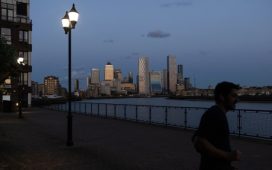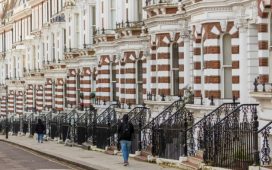Everybody I grew up with has moved out. They can’t afford to live here,” says Sallie Clarke, as she readies the offices of Home-Start Lambeth to host a Christmas party for the families the south London charity supports. There are mince pies, festive music and a Santa’s grotto.
Born and raised in Vauxhall, on the Thames between Westminster and Battersea power station, Clarke has seen dramatic changes in her home borough. Growing up in the 1980s, she knew most of her neighbours in a working-class area full of children. Soaring property prices have made these an endangered species, pushing more families to the edges of the capital and beyond.
“All my friends have moved to Kent. They’re being priced out,” she says. “You don’t get the community you used to, with people just buying and selling homes. The poor are getting poorer and the rich are getting richer.”
Britain’s biggest cities are being reshaped by soaring housing costs, as ever more people are priced out of buying or renting a home. London is the most extreme example, with house prices almost £250,000 higher than the national average, and rents at least £1,000 a month higher. But it is by no means alone in the UK.
Areas once within reach for many young adults are becoming off-limits, which leaves hollowed-out cities lived in by a dwindling mix of young and old, rich and poor. With a general election looming, housing is rising up the political agenda, as the departure of families leads to school closures and concerns about worker shortages. At the same time, suburbs and commuter towns are under pressure from an influx of priced-out families.
To plot the changes, the Observer travelled from Lambeth – where the number of households with children has collapsed by 10% since 2001, one of the capital’s sharpest declines – to Barking and Dagenham on the Essex border, where cheaper housing has meant a 34% boom in families with children.
Claire Holland, leader of Lambeth council, says the number of children in the borough’s primary schools is at its lowest in six years, with 4,400 vacant places. Two secondaries are set to close in as many years – including one that has taught the children of Lambeth for more than 300 years.
“The cost of housing exacerbates what is a London and national crisis, both in terms of falling rolls and a lack of housing,” she says, blaming national government for underfunding the building of affordable homes.
According to forecasts from London Councils, which represents the capital’s 32 authorities, Lambeth will see the biggest decline of any borough in new reception class starts, with a drop of 15% forecast by 2026.
Holland says a falling birthrate and families with EU citizenship leaving after Brexit are factors, along with the surge in remote working during Covid. “In addition, the cost of living crisis and the housing crisis leave us with challenges. And it’s all been impacted by 13 years of austerity.”
Hackney council has announced plans to close four primary schools in September as number of school-age children decline, their families prices out by waves of gentrification. The council expects single people and couples to drive most of its population growth up to 2039.
In Barking and Dagenham it is a different story. “We have the two largest primaries in the country, and the two largest secondaries, and we’re still having to build schools,” says Darren Rodwell, the council’s leader.

Walking through the Gascoigne estate, a 1960s-built area of council housing which the borough is redeveloping, he says Barking and Dagenham has produced 20% of London’s affordable housing since Covid. “We are the Whitechapel of the 21st century. We’ve welcomed everyone in.”
The area changed dramatically after waves of job losses at Dagenham’s Ford factory – where car assembly ended two decades ago, leaving an engine plant with a smaller workforce and an uncertain future. Although it is now younger and more ethnically mixed, that transition not been entirely smooth. The British National party (BNP) took 12 council seats in the early 2000s, before being turfed out in 2010.
Rodwell, who says he first stood as a Labour councillor to take on the BNP, acknowledges that the growth hasn’t been easy to manage. Other London councils have moved some of their social housing tenants to the authority’s cheaper private-sector rented homes. But Barking and Dagenham is not getting money from central government to support them. “With house prices rising because not enough have been built, all the deprivation and poverty have been placed in areas that are cheaper.”
The borough is however hoping to buck the trend by building its own properties, he says. “We want to grow. We need to grow. I don’t want to be a dormitory of the supernova called London.”
Rachael Stroganovas and her husband Domantas moved to the area this summer. Wheeling their two-week-old son, Lukas, through the centre of Barking, the couple say they wanted to buy where they grew up, in the neighbouring borough of Newham. “We wanted to live in Beckton but after the Olympics prices have rocketed,” Rachael says.

Chiara Mascitti, walking with daughter Nicole, is in a similar position. “We moved recently from Canary Wharf. We needed a bigger house: outside posh areas it’s a lot cheaper.”
Childcare in inner London is the most expensive in the country – nearly a fifth higher than in outer boroughs, according to the Centre for London. But housing costs are the biggest driver, with a growing gap in the difference between inner boroughs and outer suburbs.
“There’s an increasing incentive to move outwards,” says Antonia Jennings, the thinktank’s chief executive. “In 2004, average prices in outer London were about £200,000 compared with £225,000 for inner. By January, outer London is expected to have an average just under £500,000, but inner will be £625,000. The gap is getting a lot bigger.”
The average deposit for first-time buyers has risen by more than £20,000 over the past decade to £54,116, says Halifax – significantly higher than the average UK salary. But in London the figure is more than double that, at £113,078. Meanwhile earnings have not kept pace – with a worse picture in central London. In Lambeth, the typical home is now worth 14.4 times local average earnings, almost double the national average, and up from about five times earnings in 1997. Rising borrowing costs after the Bank of England pumped up interest rates are also having an impact. Seven in 10 Londoners say their rent or mortgage payment has increased in the last 12 months, according to London Councils. Warning that affordability problems were hitting all sectors of society, it said one in 50 Londoners were homeless and living in temporary accommodation – including 1 in 23 children – one in every classroom.
As a result the average age of first-time buyers has reached 32 in England, two years older than a decade ago, while those in London typically wait at least a year longer. Rates of home ownership in the capital have fallen from 57% in 1991 to between 49% and 53% in the past decade.
Meanwhile the proportion living in socially rented homes has collapsed since Margaret Thatcher’s right to buy policy in the 1980s. Others rely on the private rented sector, where prices are rising at the fastest rates on record.
Jennings says about 300,000 council homes have been sold off. “The majority are now in the private rental market, being rented at extortionate prices to predominantly wealthy people. We haven’t seen anywhere close to that number being built by way of replacement.”
Lambeth has the highest waiting list of any UK authority for council properties, hitting almost 34,000 households last year. It is also facing heavy criticism over the crumbling state of the council properties that remain, with hundreds of residents demanding action to fix mould, collapsed ceilings and rodent infestations. The problems have led levelling up secretary Michael Gove to write to the borough three times over its “unacceptable” practices.
Clarke’s home is affected. “It’s beyond disrepair,” she says. “There is sewage leaking through. The walls are crumbled, there are holes in the floors and the windows are rotten and falling out. It’s unfit for humans.”
Holland says the council is not complacent. “It’s a top priority,” she says. The borough is pushing to build more affordable properties, including 320 homes at Somerleyton Road, Brixton. But there is a wider context: “You can’t starve local authorities of money, reduce their power and resource, but still say they are responsible for delivering the same services.”
Lambeth was once among the cheapest places in London: in the 1970s and 80s it was full of squats and run-down Victorian terraces few wanted to live in.
Rasheed Ogunlaru is a member of the Brixton Housing Cooperative, an organisation set up 40 years ago to support people from ethnic minority and LGBT backgrounds, many of whom were squatting or couldn’t find housing. “When we first emerged we were able to buy some housing really cheap from the council because it was run down and we could work on it. The situation now is very different.”

Based on Railton Road, once the heart of south London’s squatting movement, the organisation keeps its radicalism alive, but only just, as anarchy drifts into the rearview mirror. Properties on the street now go for almost £1m.
“This is a challenge for all of us,” he says. “It’s very sad to see people who can no longer afford to live in the areas where they grew up. I’m south London born and bred. But there aren’t that many people like me who own their homes.”
While the capital is by far the most acute case, cities including Bristol, Glasgow and Sheffield are facing similar issues. School intakes are also falling in some rural communities, where populations are ageing and few new affordable homes are built. Nationally, more than 90 English primary schools are to close or at risk of closure.
Part of the reason is Britain’s declining birthrate, which dropped in 2022 to the lowest level in two decades. But housing costs influences this in some cases. In Lambeth, the number of live births was down 18% last year compared with 2000, but up 40% in Barking and Dagenham.
Another driver is benefit cuts, which, combined with sky-high rents, has pushed thousands of low-income renters out of central areas, accelerating the “suburbanisation” of poverty, according to a study by Prof Nick Bailey at Glasgow university.
“When you house large numbers of low-income households in the private-rented sector but cut levels of housing support in a market where prices are rising, the inevitable consequence is they’re pushed out,” he says.
In London, Westminster is unusual in seeing a widespread loss of people claiming housing benefit, he says. This is also true in Kensington and Chelsea and parts of Wandsworth and Hackney. Meanwhile levels are rising in Barking and Dagenham, Redbridge, Newham, Barnet and Enfield.
The capital has always seen its inhabitants push for the suburbs: from the rise of Metroland in the early 20th century, and the resettlement to Essex and the home counties of bombed-out east Londoners, to the 21st-century conveyor belt of graduates arriving for City or creative industry careers – only to leave in their 30s to start a family.
Bailey says notoriously bad state schools in inner boroughs once drove young families away in the 1990s, before vast improvements reversed the trend. However, skyrocketing housing costs are now the prime culprit.
“You had started to see families sticking around in cities for longer. But that seems to have been halted in London, if not reversed.”











